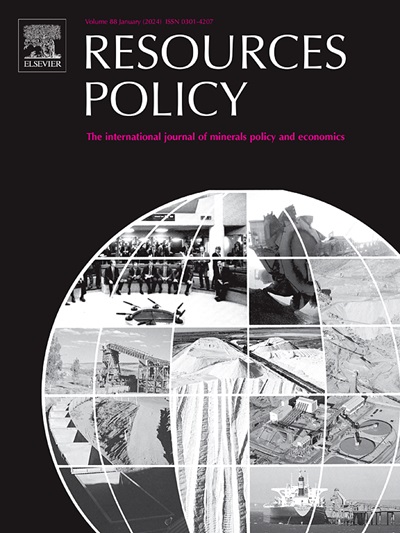Graphite and manganese mining in the U.S.: Proposed projects and federal battery mineral policies
IF 10.2
2区 经济学
0 ENVIRONMENTAL STUDIES
引用次数: 0
Abstract
Demand is increasing for the minerals used in energy transmission and storage, such as graphite and manganese in batteries. These two commodities are produced in relatively few locations around the world, and major consumers such as the European Union (EU) and the United States (US) are highly reliant on imports, especially for refined products from China. In the US, graphite and manganese are not currently mined. In efforts to avoid geopolitical supply chain disruptions, the U.S. federal government has implemented new policies promoting domestic mining and processing of critical minerals. This contribution reviews the geological resources and development status of graphite and manganese projects in the U.S. and examines the impacts of policies on U.S. mining and processing of these two commodities. Measured, indicated, and inferred resources of 20.9 Mt are known for graphite, including 3.7 Mt of reserves. Resources of 50.5 Mt are known for manganese, with no established reserves. Graphite exploration is in advanced stages in Alaska and Alabama and in early stages in Montana and New York. There is one operating processing plant for natural graphite in Louisiana and one is under construction in Alabama. Synthetic graphite is produced in one plant in New York, and synthetic graphite plants are under construction in Georgia and Tennessee. One manganese mine is in permitting review in Arizona, and manganese exploration is underway in Minnesota and Arizona. Historic manganese mines in Arkansas, Maine, Colorado, Nevada, and Montana are unlikely to reopen in the near term, and exploration for manganese on the seafloor is in very early stages. The potential for known resources to meet demand is modeled based on three energy transition scenarios and a range of battery share assumptions, showing that known graphite resources are likely sufficient to meet future U.S. demand for hundreds of years, whereas manganese resources are sufficient to meet only decades of projected U.S. demand. Supply bottlenecks will arise if these projects do not progress into development. Policies intended to spur domestic production include the Biden administration's Bipartisan Infrastructure Law of 2021, the 2022 authorization of the Defense Production Act, the 2022 CHIPS in Science Act, the 2022 Inflation Reduction Act, as well as the second Trump administration's 2025 executive orders on Unleashing American Energy and Unleashing America's Offshore Minerals and Resources. Potential shortfalls include overemphasis on processing compared to mining, insufficient incentives, and a contentious regulatory framework for both terrestrial and deep sea mining.
美国的石墨和锰矿开采:拟议的项目和联邦电池矿产政策
对用于能源传输和储存的矿物的需求正在增加,例如电池中的石墨和锰。这两种商品的生产地点在全球相对较少,欧盟(EU)和美国(US)等主要消费国高度依赖进口,尤其是来自中国的精炼产品。在美国,目前还没有开采石墨和锰。为了避免地缘政治供应链中断,美国联邦政府实施了促进国内关键矿产开采和加工的新政策。这篇文章回顾了美国石墨和锰项目的地质资源和开发状况,并研究了政策对美国这两种商品的开采和加工的影响。已知的测量、指示和推断的石墨资源量为2090万吨,其中包括370万吨的储量。已知的锰资源量为5050万吨,但没有确定的储量。阿拉斯加和阿拉巴马州的石墨勘探已进入后期阶段,蒙大拿州和纽约州的石墨勘探已进入早期阶段。路易斯安那州有一家正在运营的天然石墨加工厂,阿拉巴马州有一家正在建设中。纽约的一家工厂生产合成石墨,乔治亚州和田纳西州的合成石墨工厂正在建设中。亚利桑那州的一个锰矿正在接受许可审查,明尼苏达州和亚利桑那州正在进行锰勘探。位于阿肯色州、缅因州、科罗拉多州、内华达州和蒙大拿州的历史悠久的锰矿不太可能在短期内重新开放,海底锰的勘探还处于非常早期的阶段。已知资源满足需求的潜力基于三种能源转型情景和一系列电池份额假设进行建模,表明已知石墨资源可能足以满足美国未来数百年的需求,而锰资源仅足以满足美国几十年的预计需求。如果这些项目不能进入开发阶段,就会出现供应瓶颈。旨在刺激国内生产的政策包括拜登政府的《2021年两党基础设施法》、《2022年国防生产法》授权、《2022年科学芯片法》、《2022年通货膨胀减少法》,以及特朗普政府第二任期的2025年《释放美国能源》和《释放美国近海矿产和资源》行政命令。潜在的不足包括与采矿相比过度强调加工,激励措施不足,以及对陆地和深海采矿有争议的监管框架。
本文章由计算机程序翻译,如有差异,请以英文原文为准。
求助全文
约1分钟内获得全文
求助全文
来源期刊

Resources Policy
ENVIRONMENTAL STUDIES-
CiteScore
13.40
自引率
23.50%
发文量
602
审稿时长
69 days
期刊介绍:
Resources Policy is an international journal focused on the economics and policy aspects of mineral and fossil fuel extraction, production, and utilization. It targets individuals in academia, government, and industry. The journal seeks original research submissions analyzing public policy, economics, social science, geography, and finance in the fields of mining, non-fuel minerals, energy minerals, fossil fuels, and metals. Mineral economics topics covered include mineral market analysis, price analysis, project evaluation, mining and sustainable development, mineral resource rents, resource curse, mineral wealth and corruption, mineral taxation and regulation, strategic minerals and their supply, and the impact of mineral development on local communities and indigenous populations. The journal specifically excludes papers with agriculture, forestry, or fisheries as their primary focus.
 求助内容:
求助内容: 应助结果提醒方式:
应助结果提醒方式:


